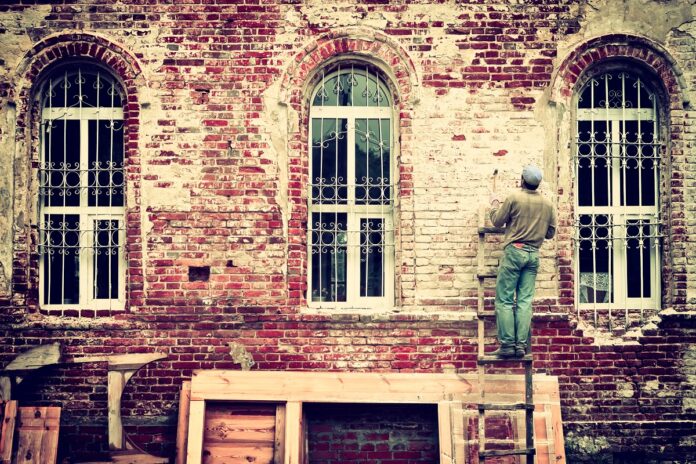When thinking of renovating a heritage property, it is important that you do your research and ensure that you have obtained all the necessary planning permission. This handy guide will help you understand how to plan and prepare for renovating a listed building.
What to consider when planning a listed property renovation
Consent
The first thing that you will have to consider is consent. Upgrading and changing parts of heritage properties requires listed building consent as the government want to save and protect that history and heritage that comes with these buildings. A list of every listed building in the UK can be found through the relevant agency (Historic Scotland, Historic England, Historic Wales or the Built Heritage Directorate of the Northern Ireland Environment Agency). Their records will show what sections or aspects of the building make it a listed building – this could just be the building itself or may include the surrounding grounds. If your home is on this list, then you will need to apply for planning consent before you start any building work. This may include both interior and exterior changes, so it is best to check this with the historic organisation in your area.
When it comes to listed buildings, there are three categories. Buildings that are of the highest historical significance are labelled Grade I buildings, buildings of slightly less significance are Grade II, and then it reduces to Grade III. Most owners of listed buildings are likely to stay in a Grade II building as these make up 92% of all listed buildings.
Retrospective Consent
If you have already completed some renovations, then you may need to look into retrospective consent to avoid any legal action. Retrospective consent is essentially applying for historic approval to ensure that your building is up to standard.
Conservation Areas
If your building is in a conservation area, then this may add another hurdle to your heritage home renovation. Not only do you have to ensure that your buildings history is preserved when you undertake any renovations, but you also have to keep your renovations in line with the area as a whole. Therefore, they require extra planning permission which is likely to affect any exterior renovations.
In order to get the appropriate planning for these alterations, you will need to apply to both the local council and your local heritage board. If you are looking to make changes to your garden then keep in mind the fact that trees in conservation areas are usually protected by Tree Preservation Orders to protect the nature in the area. You will need planning if you intend to cut these down.
How long does it take to get consent?
Many local councils have a targeted turnaround time of around 8 weeks if the work you are undertaking is small. This is only a target however, and it may take longer if they council are overwhelmed with applications.
During this period of time, the council will consult your neighbours and other interested parties to get their opinions and feedback on your renovations, to ensure that there are not issues.
To try and keep the turnaround time low, it may be possible to arrange a pre-application meeting with a conservation officer. They will be able to give you guidance on both your building plans and your application. If there are any major issues, they can identify these before submitting your application, which will hopefully allow a smooth process.
What alterations can I make to a Grade II Listed building?
Generally, if you are simply maintaining the look of your property you will not need to apply for permission. However, if you are making changes to the way that it looks then you will. For example, painting some of the exterior of your building in the same colour just to freshen it up will not require planning permission but replacing the materials with new ones would. If you are unsure if your work needs permission, then contact your local council before submitting an official application and they should be able to give you advice.
If you are looking to replace broken windows or add double glazing, then be careful and make sure that you apply for planning as modern materials may not fit in with the aesthetic of your heritage home and could be rejected. There are some companies that will repair or replace windows with ones that fit in more with the character of your building but these are often more costly.
When you are looking to extend a listed building, planners nowadays do not mind if you create an extension out of more modern materials that complement the original materials, rather than ones that copy them entirely.
Finding the right people to work on heritage properties
Contacting your local conservation organisation is a great way to find architects and builders who understand the requirements of working on heritage properties. For example, the Historic Scotland website has a contact number that allows you to speak to an adviser on the phone who can direct you towards trusted experts and tradesmen. The Royal Institute of British Architects also has a website which has some great information on renovating listed buildings. The final place to look for trusted workers would be The Listed Property Owners Club who have a database of experts that are highly recommended.
How much does it cost to renovate a listed property?
It is difficult to estimate how much it will cost as each and every property is different. As a general estimation, experts believe that building costs will be roughly £1200-1500 per square metre for normal properties. However, listed properties tend to be more expensive as they usually involve different materials and high skilled workmen. It is estimated that costs could be as much as 30-50% higher.
When thinking of costs, consider the amount of time that it would take for the work to be completed. If you ensure that planning permission has been granted, and architects plans are detailed, then this could mean that builders spend less time on your property as they know exactly what they are doing – and remember time is money!
In order to cut costs you could try and teach yourself some of the skills and try your hand at a little DIY, although this can be more difficult with period properties. If you are looking for authentic period furniture or features, then perhaps visit a salvage yard as it will have a lot of original features for lower prices.
Obtaining a grant
If you are looking to cut the cost of your renovations, there are grants available for work on heritage properties, but they are few and far between. In order to try and access these finds you need to justify why you need the funding and what the historical significance of these changes would be. Many local councils have small grants that you can access so it is worth contacting them to see what funding is available.
Other sources of funding could be from Historic England (or the relevant authority in your area) or the National Lottery Heritage Fund.
Do’s and don’ts
Do’s
- Build a relationship with the local conservation officer – having them on your side is a massive advantage as they are more likely to assist and give advice. They know about listed buildings and the barriers there can be to improve them, so the more advice you get, the better.
- Ensure that you have planning for all alterations that have already been made to your building, even if it was the previous owners that completed the work as you will still be liable if you now own the building.
- Take out home insurance for listed buildings – There are many specialist insurance companies that can cover more specific issues that come with owning a listed building. This will be beneficial as if your home is damaged, the conservation officer will ask for anything damaged to be replaced with similar materials so that it fits in with the rest of the house. Standard insurance policies may not cover this, and therefore specialist insurance is a must!
- Stay organised – as renovating a heritage property can be a long process it is important to keep on top of all the paperwork and planning approvals. Even after the work is fully complete, ensure that you keep a record of all the paperwork as you will need this if you wish to sell your home on in the future.
- Understand VAT – You can save yourself money if you understand how Value Added Tax works. If you are making improvements to your home that allow it to be more energy efficient, then you only need to pay 5% VAT on these costings. You are not able to reclaim these retrospectively, so it is important to check that your invoices reflect this saving.
DON’TS
- Don’t change or get rid of key original architectural features are these are often linked to the property’s listed buildings status and your application will probably be rejected.
- Don’t try and repair traditional features and materials with modern alternatives. Most period properties are built with lime mortar and trying to repair this with cement for example will cause lasting damage.
- Don’t assume anything about what is included in the ‘listed’ category. Often it includes garden walls, trees and gates so you need to enquire about whether permission is needed for these aspects too.
- Don’t rush the process. Listed buildings have been around for years and require careful planning and attention to detail when trying to upgrade. Make sure that you contact as many experts as possible, as these are the people that have done this hundreds of times before.






